To Search for People:
1.Click the People icon. A pop-up list appears.
2.Click People View. The People screen appears.
NOTE: Alternatively, set focus on the toolbar and press ALT+P to display the People search screen.
This search form lets you search 69 of the most useful fields related to a Person. In the bottom one-third of the screen, you may search for document content in 6 different ways.
A data base field search can be done independently of a document content search. A document content search can be done independently of a data base field search. A concurrent search of database fields and document content can be done.
All document content is searchable except for common 'noise' words such as: I, the, and.
All documents are full-text indexed when the database is first installed.
New documents or changes to existing documents are indexed immediately on SQL2005+
The text boxes for data fields may contain multiple phrases separated by commas.
Each comma is interpreted as an OR and spaces are ignored.
Example of a two-field database search:
The logical syntax for a two-field search is:
Find People where Title starts with (Vice President OR VP) AND Company starts with (IBM OR Accenture OR Oracle).
Example: People Two-field search

Example: Two-field search combined with a search for two phrases in Resumes/CVs

![]()
![]()
The logical syntax for this example is:
Find People where Title starts with (Vice President OR VP) AND Company starts with (IBM OR Accenture OR Oracle) AND Resume contains the phrases (Finance AND Mergers and Acquisitions).
Example of a Skills search combined with phrase search:
This query searches for People with three skill codes and for People whose Resumes/CVs contain aliases for the three phrases: Business Development, Business Management, Marketing.
Example: Search for Skills, Phrases and Phrase aliases in Resumes
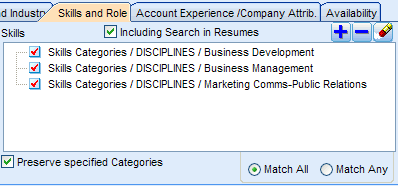
Example of a Role code search:
This search is for People who match any of three Role Codes.
Example: People Search for any of three role codes
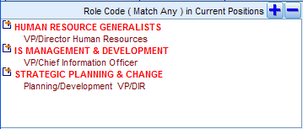
Example of a Phone Number search:
This search is for People who have any phone number in either area code 613 or area code 416
Note the inclusion of the wild card character, %, to overcome formatting characters such as (
Note that the comma means OR

Example of a Job Title search at three Companies:
This search is for People who worked as a Vice President for any of three Companies between a range of dates.
Search for Vice Presidents who worked for any of three Companies over a specified date range

NOTE: The check box called Look in Current Positions only is not checked.
Examples of a Wild Card Search:
The wild card in Deskflow is the percent sign %, and it can be placed in front of or behind a text string.
For example, the search phrase %Vice will find all People whose job title contains the test string Vice anywhere in the job title. So the following results could be expected from the search:
•Senior Vice President.
•Junior Vice Consul.
•Ex Director of Miami Vice.
•Not a Vice President.
Another use for the wild card in a search is to find text when you are not sure of the structure or spelling. So a search using the phrase %Vice%Pres%Of% could return these results:
•Ex Vice-President of Sales.
•Senior Vice Pres and Manager of Sales.
•Viceregal Consul and President of Rotary.
Examples of a Skills Alias Search:
Assuming that the Skill called Business Development has two aliases called Marketing and Sales Management, then a Skills search combined with a Resume/CV search will give a list of all Candidates who have a Skill called Business Development or Candidates whose resumes/CVs contain the phrase of either Marketing or Sales Management.
Results of a Search:
The result of doing a People search is a List of People. If the result has only one record, then the detail record is opened. A list is useful for browsing many records on one screen. The following actions can be performed on a browse list:
Open one of the detail People records |
Send a Fax to the list of People |
Send an email to People in the list |
Scroll up or down the list |
Create a report on the list |
Scroll to the top of the list |
Save the list in a folder by name for later re-use |
Scroll to the bottom of the list |
Export the list to Excel |
Sort the list on any column |
Batch update every record in the list |
Change the column order and column width of the list |
View the resumes for the list of People |
Show/Hide columns in the list |
View the activity history for the list of People |
Maximize the window size of the list |
Extract and display text Resumes for People in the list |
Customize and remember the window size of the list |
Example: People list sorted by Last Name
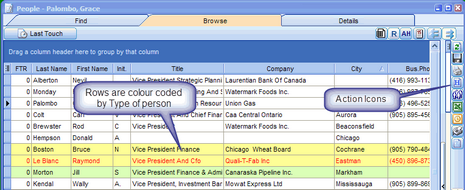
Example: People List showing Resumes/CVs
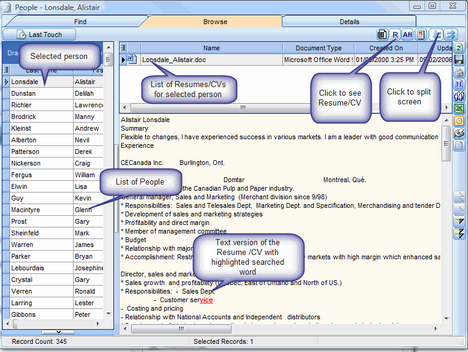
Example: People List showing Availability
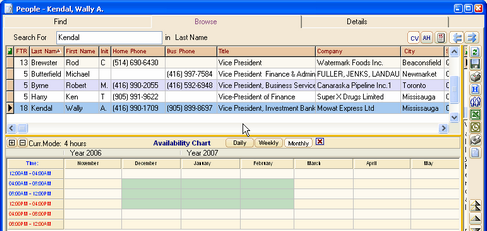
Example: People List export to Excel (including resumes)
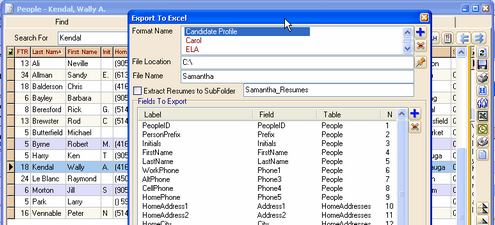
Example: People List used for an Email Broadcast
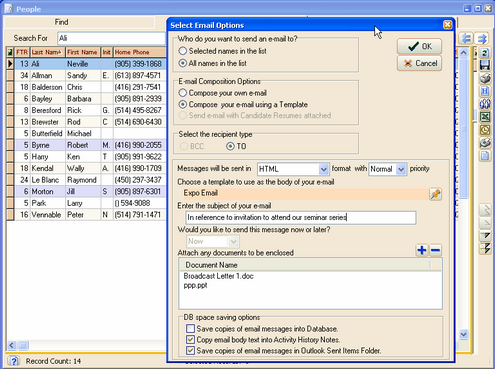
Example: People List used to Display a Report
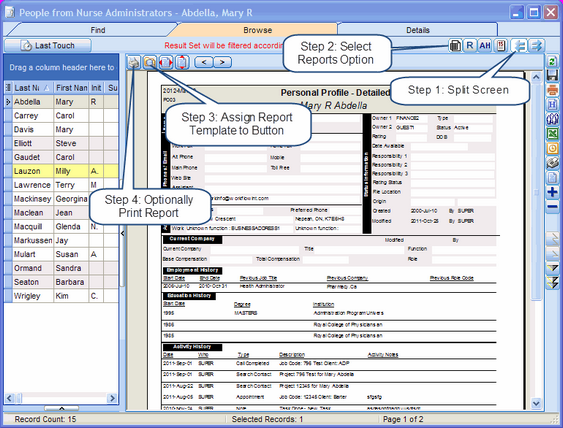
The Candidate Search screen enables a User to search for database content from pre-defined fields, and combine the Search with a concurrent search of resumes, cover letters and text notes for People and activity history. The result of a search is a list of Candidates (or People). If only one record is found, the detail profile opens.
•Enter text in any of the fields. The search is an AND search on fields with text.
•Several text strings, separated by a comma, may be entered in any text field. The comma designates an OR condition.
•All fields assume an anchored, left justified search (item begins with).
•Resume/CV text search strings must be separated by commas, hence text containing a comma cannot be searched for.
•The By Activity History and Skills tab provides a search for skills and their aliases, and will concurrently search the resumes/CVs for the aliases. The result will be a list. Click Show Resumes on the top right. All skills and aliases will be highlighted in blue, and all phrases found in the resumes/CVs will be highlighted in red.
•To search for Candidates who work for say any of three Companies, enter the search string in the Company text box as: Companyname1,Companyname2,Companyname3.
Candidate Search 2 - Sub folders
•Enter text in any of the text boxes representing database fields. The search is an AND search.
•Resume/CV text search strings must be separated by commas, hence text containing a comma cannot be searched for.
•The Personal Attributes tab provides a search of codes related to a Person, Salary information, Language, Job order postings to which a Candidate applied, project postings to which a Candidate applied, and birthdays. Note: Many countries prohibit the retention of age, gender and birthday information. For Deskflow Clients in these jurisdictions, the birthday, age and gender information is removed.
•The Activity History and Industry tab provides a text search of activity history notes, and also for Company industries. The industry search will find Candidates or People that currently or previously worked for Companies in the designated industries.
•The Skills and Role tab is useful when skill codes or role codes have been applied to People and Candidate records. Role codes are associated with employment records, whereas skill codes are associated with a person.
•The Account Experience tab is for searching for Candidates or People that have had marketing or sales responsibilities for designated Companies.
•The Availability tab is for searching for Candidates based on their availability. For Candidates that are working on contracts recorded as Deskflow Contract Job Orders, the availability date is the end date of a current contract.
Helpful Hints
1.Search for People using a query form. Search for ALL Items entered in separate text boxes. Within a single text box, ANY items separated by commas are searched for.
2.LastName can be first few letters, or can for example be %Andrew to search for MacAndrew and McAndrew.
3.Title can have multiple values separated by commas. For example, search for any of these: Vice, President, Treasurer, Controller.
4.Role Code and Function Description are interchangeable.
5.For a Position search, the default is for current position. Click the Since check box to search for current and previous positions.
6.For Company search, separate values with commas. Example, IBM, International Business.
7.For city, state, zip code, etc. searches, separate multiple values with commas. Searches ANY not All.
8.Date range searches require start and end dates.
9.Cover letter search is for a single phrase. Cover letters are not full-text indexed, so expect long search time.
10.Resume/CV word or phrase search uses a full-text index, so it is quick. New resumes/CVs are only indexed at set time intervals, such as daily, hourly etc. so a search will not retrieve newly entered resumes/CVs – until incremental indexing is completed. Separate words and phrases with commas, and set the ANY or ALL preferences check box to suit.
11.Search Resumes/CVs for all forms of standard words such as drove, driving, driven.
12.Single letter searches are not possible. Certain characters such as + ‘ – etc are also not searchable.